skills acTion Plan for The food and Beverage secTor - Department of ...
skills acTion Plan for The food and Beverage secTor - Department of ...
skills acTion Plan for The food and Beverage secTor - Department of ...
Create successful ePaper yourself
Turn your PDF publications into a flip-book with our unique Google optimized e-Paper software.
Inputs<br />
Outputs<br />
Types <strong>of</strong> Decisions<br />
• Benchmark historical<br />
• Default scenario<br />
• Recruitment<br />
data (Census,<br />
Business Directory,<br />
(ie. Labour<br />
requirements by<br />
• Immigration<br />
ITO data)<br />
• Exogenous<br />
production volume<br />
<strong>for</strong>ecasts (wine &<br />
dairy industry)<br />
Forecasting<br />
Framework<br />
Application<br />
occupation <strong>and</strong><br />
qualifications)<br />
• Alternate scenario 1<br />
• Alternate scenario 2<br />
• Tertiary education<br />
<strong>and</strong> training<br />
• Wages<br />
• Career promotion<br />
• Parameters (eg.<br />
value added in the<br />
production chain,<br />
• Capital investment<br />
<strong>and</strong> use <strong>of</strong><br />
technology<br />
labour turnover,<br />
labour productivity,<br />
fulltime/part time)<br />
• Stakeholder<br />
interviews<br />
(fertility <strong>and</strong> migration) <strong>and</strong> work<strong>for</strong>ce changes (ie. greater<br />
participation <strong>of</strong> women <strong>and</strong> older workers) will be taken into<br />
consideration.<br />
<strong>The</strong> <strong>for</strong>ecasting framework developed <strong>for</strong> the <strong>food</strong> <strong>and</strong><br />
beverage sector has suggested an approach which utilises<br />
available <strong>for</strong>ecasts (<strong>of</strong> product output) <strong>and</strong> existing data<br />
<strong>and</strong> parameters to derive future employment levels at<br />
some level <strong>of</strong> detail. In that process, the need <strong>for</strong> more<br />
up-to-date <strong>and</strong> consistent data has also been identified to<br />
make the results (eg. occupations <strong>and</strong> qualifications) more<br />
relevant.<br />
<strong>The</strong> key components <strong>of</strong> the <strong>for</strong>ecasting framework are<br />
outlined above.<br />
<strong>The</strong> inclusion <strong>of</strong> labour turnover allows <strong>for</strong> an assessment<br />
<strong>of</strong> replacement dem<strong>and</strong> <strong>of</strong> the existing workers in each<br />
value-chain to be estimated along with the additional<br />
derived dem<strong>and</strong> <strong>for</strong> labour as a result <strong>of</strong> output changes.<br />
<strong>The</strong> share <strong>of</strong> occupations in each value chain <strong>and</strong> the<br />
qualifications <strong>of</strong> those employed are based on the 2001<br />
census results <strong>and</strong> have been maintained at this level over<br />
the <strong>for</strong>ecast period (2006-10). <strong>The</strong>se can be updated when<br />
the 2006 census results on occupations <strong>and</strong> qualifications<br />
shares in <strong>food</strong> <strong>and</strong> beverage sub-sectors <strong>and</strong> value chains<br />
are made available by Statistics New Zeal<strong>and</strong> (SNZ).<br />
APPLICATION OF THE FORECASTING<br />
FRAMEWORK<br />
Overview <strong>of</strong> Results<br />
Comparisons <strong>of</strong> recent (2000-05) changes in employee<br />
counts <strong>and</strong> full-time equivalent employment in the <strong>food</strong><br />
<strong>and</strong> beverage sector, in comparison to the overall labour<br />
market are summarised below:<br />
23


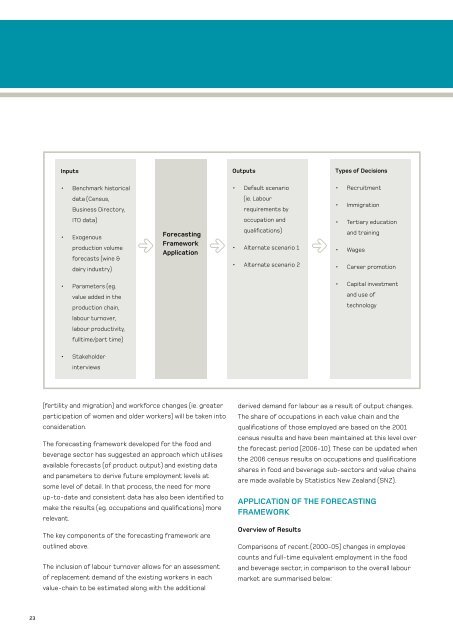
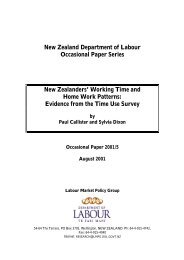

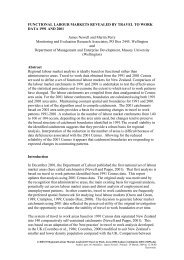
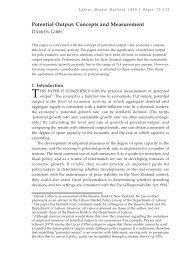

![a note on levels, trends, and some implications [pdf 21 pages, 139KB]](https://img.yumpu.com/27285836/1/184x260/a-note-on-levels-trends-and-some-implications-pdf-21-pages-139kb.jpg?quality=85)


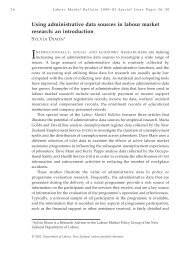
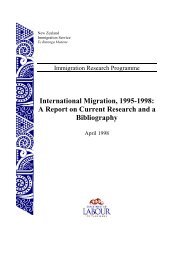
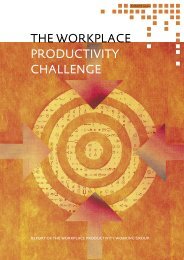
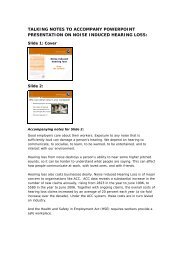
![Labour Market Trends and Outlook - 1996 [pdf 18 pages, 94KB]](https://img.yumpu.com/27285764/1/184x260/labour-market-trends-and-outlook-1996-pdf-18-pages-94kb.jpg?quality=85)

